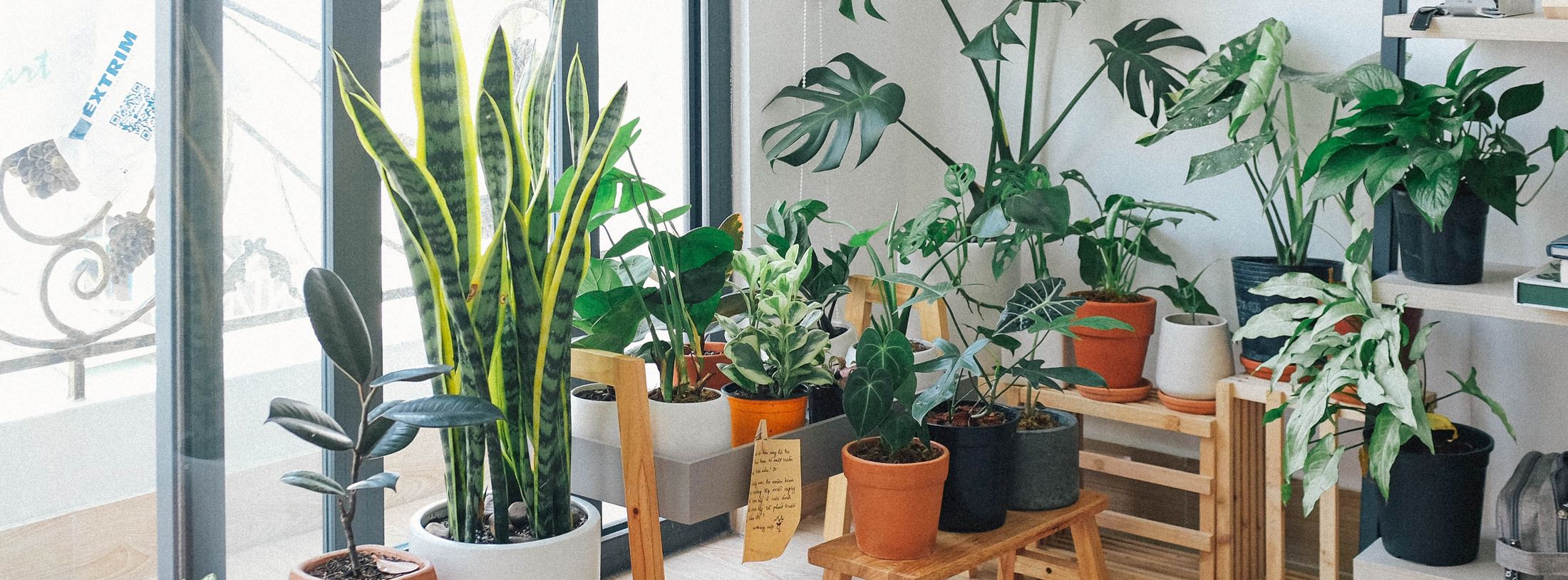How Do We Measure Air Quality?
Air quality is closely tied to air pollution, which is a collection of not-so-great gasses and particulates suspended in the airOpens in a new tab.. These particles can include ozone, aerosols, pollen, dust, and a host of other pollutantsOpens in a new tab..
The Air Quality Index, or AQI for short, helps translate numerical data into information the public can understand. It’s a way to help determine the level of pollution and the health dangers they may cause.
The potential impact on a person’s health can be influenced by the specific pollutant present, the level and time of exposure to said pollutant, and the age or genetic background of the person affected.
What Are Good Ways To Improve Air Quality?
People spend a lot of time indoors. It’s common knowledge that indoor air quality is more than a little lacking. It’s slightly harder to live, laugh, and love when you feel surrounded by dust, dirt, and allergens.
If you want to help improve your indoor air quality, you need to reduce possible pollutants in and outside the home (https://www.canada.ca/en/health-canada/services/air-quality/improve-indoor-air-quality-in-your-home.html).
Here are just a few ways to do that:
- Do not smoke or vape indoors, including near open windows.
- Vacuum your carpets and rugs regularly.
- Wash or dry clean your curtains and other linens often.
- Keep mold at bay by keeping humidity levels low.
- Groom pets frequently and maintain pet bedding.
- Use chemical-free household products to minimize toxins inside.
- Air out your home using open windows, ceiling fans, or a window fan.
These are simple ideas to help improve your home and your indoor environment. But how do you know if your home has air quality problems? There are a few ways you may be able to tell.
How Do You Know You Have Bad Air Quality?
Having up-to-date smoke, carbon monoxide, and radon detectors is a necessity. While those tools can help you avoid a fire or harmful levels of naturally occurring radioactive gas, other less obvious signs indicate a potential interior air problem.
Bad air quality may include some or all of the following signs or symptoms.
Coughing and Difficulty Breathing
Breathing in dirty air means dust, ash, or other particulates can enter your respiratory tract and irritate your lungs. High concentrations of these pollutants can cause chronic coughing or regular asthma attacks.
Sneezing and Allergic Reactions
Certain particles may also be allergens. Allergies can bring on various symptoms ranging from sinus infections to itchy or watery eyes and even general fatigue. Dust, mold, and pet dander are common indoor allergens.
Skin Irritation
Poor indoor air quality can also affect the condition of your skin. These pollutants can irritate or block your pores, causing breakouts or rashes.
Headaches and Migraines
Certain pollutants, like aerosols or fumes, can reduce the amount of oxygen in your lungs, and, therefore, your brain, leading to dizziness and feeling faint. Problematic indoor air can also contribute to more frequent headaches and migraines (https://headaches.org/poor-indoor-air-quality-leads-to-migraine-and-headache/).
Unpleasant Smells
Stagnant air and uncontrolled humidity levels can build up odors from various sources, including mold or decay. In closed indoor spaces, especially those with poor ventilation, foul odors can linger in the air.
How Do Plants Improve Air Quality?
Plants are natural experts at air purification. In the general process of photosynthesis (https://education.nationalgeographic.org/resource/photosynthesis), plants uptake carbon dioxide and transform it into sugar while releasing oxygen. However, various other studies have found that plants can also remove other airborne pollutants.
But there’s a catch.
In a 1989 study conducted by NASA, several houseplants were found to remove volatile organic compounds (VOCs) (https://ntrs.nasa.gov/citations/19930073077) such as benzene and formaldehyde from the air. More recently, in 2022, another study (https://link.springer.com/article/10.1007/s11869-022-01171-6) measured plants' capability to remove noxious nitrogen dioxide.
Both studies confirmed plants' ability to purify the air in certain environments. However, “certain environments” is the key phrase.
In these studies, as well as other similar experiments, the tests were performed and measured in a sealed chamber. Outside of quarantine, most individuals do not live or interact in hermetically-sealed rooms.
According to a 2019 review, since most living spaces are larger, ventilated, and more likely to have continuous exchange with outside gasses, the purifying effects achieved by standard house plants would not significantly affect air quality (https://go.skimresources.com/?id=138113X1700773&isjs=1&jv=15.2.4-stackpath&sref=https%3A%2F%2Fwww.popsci.com%2Fenvironment%2Fhouseplants-air-quality-purify%2F&url=https%3A%2F%2Fwww.nature.com%2Farticles%2Fs41370-019-0175-9&xs=1&xtz=420&xuuid=b07364784597d420bbaf2358c349b03c&xcust=xid%3Afr1661841862864jah&xjsf=other_click__auxclick%20%5B2%5D).
In order for these species of houseplants to have an impact, there would need to be a lot of them present, and we mean a lot.
Which Plants Are Best for Air Quality?
There’s no need to exile your potted plants just yet. Plants still have amazing capabilities for filtering air and sprucing up our home decor. From slow-growing plants to small space plants, we’re not saying you can’t find a spot on the sill to help brighten your living room.
As we look into improving our living spaces, let’s examine popular low-maintenance plants to see which could be the best indoor plant for you.
The right houseplant for improving indoor air quality may be an unexpected option.
Philodendrons
Deriving from the Greek words philo- meaning “love,” and -dendron, meaning “tree,” philodendrons are one of the largest genera in the Aroid family. You may recognize the Aroid family for other common plants including monstera deliciosa (the Swiss cheese plant), philodendrons, pothos, and ZZ plants.
Commonly revered for their heart-shaped leaves (which explains their name), philodendrons come in many shapes, sizes, and even growing patterns. They prefer very little watering.
In a NASA study, philodendrons were found to be quite competent in removing formaldehyde from the air. Philodendrons are versatile as climbing epiphytic plants or trailing plants. These plants adapt to a variety of light conditions and can thrive in low to medium light as well as indirect sun.
Chinese Evergreen
As another member of the Aroid family, Chinese evergreens, or Aglaonemas, are another low-light houseplant. Imported to the United States in the late 1800s, the Chinese evergreen is commonly gifted as a good luck plant.
Similar to philodendrons, Chinese evergreens are believed to help filter formaldehyde and benzene. Skip the bright light or direct sunlight. These variegated plants prefer indirect sunlight (low light to medium light) on a windowsill.
Snake Plant
Believe it or not, the snake plant belongs to the same family as asparagus. Snake plants have been used as medicine in some parts of the world but are toxic when consumed in large quantities.
This popular houseplant is adored by many beginner house plant enthusiasts for its easy-growing nature and simple plant care requirements. A snake plant is adaptable to many different growing environments, including low light conditions.
Snake plants may help filter both formaldehyde and benzene, as well as trichloroethylene, xylene, and toluene.
Spider Plant
Popular since the age of disco in the 1970s, the spider plant is a cousin of the snake plant. Prized for its incredibly low maintenance and being suited for those without a green thumb, the spider plant is also loved for its ability to put out small “pups,” or clones of itself.
When spider plants first appeared on the scene, many people obtained their plant from a close friend or relative. These plants are easy to propagate.
The spider plant is another plant capable of potentially filtering out formaldehyde, xylene, and toluene, as reported in the same NASA study.
Peace Lily
The peace Lily is a statement tropical plant with its stunning large green foliage and the ability to bloom reliably under proper care. They can grow and increase in size for years and need only moderate indirect light and water to thrive. This is a plant that prefers to dry out between waterings, so avoid overwatering this one.
Peace lilies are not, in fact, true lilies. These plants also belong to the Aroid family. In the NASA study and 2022 study, the peace lily was found to be one of the most effective and efficient purifiers of the studied house plants.
These green leaves are believed to be able to filter formaldehyde, xylene, toluene, trichloroethylene, benzene, and ammonia, as well as both carbon and nitrogen dioxide.
Neoplants
Although not available quite yet, Neoplants are a new generation of air-purifying house plants. With roots in France and a composition of engineers, researchers, molecular biologists, and chemists from across the globe, Neoplants offers not just a new plant, but new innovation.
These bioengineered super plants (https://neoplants.co/) are designed to help battle air pollution inside of your home, one beautiful leaf at a time. With dozens of scientists collaborating to create a positive impact, Neoplants combine creativity and function (with a heavy dose of organic beauty).
The Bottom Line
A little bit of greenery helps pep up every part of our homes. Don’t depend on the typical houseplant to improve indoor air quality outside of a sealed room. To truly clean and freshen up the air inside your home, you’ll need to turn to science.
Neoplants are the world’s first bioengineered plants crafted to improve indoor air quality. Help support a sustainable step forward in the fight for a greener future. It’s a simple change you can make to push the needle in the right direction.
Looking to stay up-to-date on Neoplants happenings? Sign up for our email list here and stay in the loop for one of Earth’s biggest developments happening on a molecular level.
Sources:
Air Pollution and Your Health | NIEHS (https://www.niehs.nih.gov/health/topics/agents/air-pollution/index.cfm)
Air Quality | AQMD.gov (http://www.aqmd.gov/home/air-quality)
Improve Indoor Air Quality in Your Home: Canada.ca (https://www.canada.ca/en/health-canada/services/air-quality/improve-indoor-air-quality-in-your-home.html)
interior Landscape Plants for Indoor Air Pollution Abatement | NASA Technical Reports Server (NTRS) (https://ntrs.nasa.gov/citations/19930073077)
Photosynthesis | National Geographic Society (https://education.nationalgeographic.org/resource/photosynthesis)
Potted Plants can Remove the Pollutant Nitrogen Dioxide Indoors | SpringerLink (https://link.springer.com/article/10.1007/s11869-022-01171-6)
Potted Plants Do Not Improve Indoor Air Quality: a Review and Analysis of Reported VOC Removal Efficiencies | Nature.com (https://www.nature.com/articles/s41370-019-0175-9.epdf?sharing_token=KJzKrtW6-EIUGqEC8IZRmtRgN0jAjWel9jnR3ZoTv0PcoA8kdTur87_FnP9dFdH6px7NlRJmj-DbFof_EwcIUv-MEbYvUhfI2BD38NlfD_S0epa5afXgOfl58EVmN065Oelei_OEeX8NjQbk-M85KIYP9_7A4hKEIqYZFYzJwOFVaUx5Xte42qqrApdbNeZzmX80GwPPxFEyu11Slpkwyex6DGTeUkNamwV1bVCVwCE%3D&)

